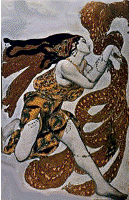

|
| ||||||||||||||||||||||||||||||||||||||||||||||||||||
|
| ||||||||||||||||||||||||||||||||||||||||||||||||||||
 history of Recordings and recording—Page 3about advances in Recording and playbackRecording and the arts have always been inextricably linked. Throughout history, man's urge to produce more, different, and better art has led to advances in recording technology. In turn, advances in recording technology have enabled civilization to make advances in the arts. The history of art is in large measure the story of recording and advances in recording; and the history of recording is in large measure the story of art and advances in art. These two stories must be told together. Arts such as carving or rock painting have been with us a long time—up to 40,000 years. (An example of Aborigine rock painting is shown at the right.) All that time had to elapse before mankind took its next major step: He invented writing.
This first writing was done in a script called cuneiform by a scribe who traced characters (groups of short, shaped lines) onto a flattened lump of soft clay with a wedge-shaped reed stylus. Sentences composed of groups characters were inscribed in horizontal lines across the clay. Multiple lines comprised what we would call a document. The clay would then be allowed to harden into a tablet (a record) which could be stored and retrieved later (a display). A tablet is shown at the right for illustration. The markings are in centimeters.
Initially, writing was used primarily to keep track of business transactions. Although invented for commerce and limited as a medium of self-expression, cuneiform writing soon found other applications. It became the primary mechanism for communications among states, for conducting government, and for recording and disseminating laws. Egypt, a powerhouse of the time, quickly adopted it. So did Babylon. the ability to write was not only a giant step forward for commerce and politics, it advanced the arts. One of Cuneiform's principle functions was religious and aesthetic. We owe the preservation of Sumerian, Assyrian, and Babylonian myths to the clay tablets uncovered in 19th and 20th century archeological excavations. Some of these "documents," purported to be accounts of the acts of gods, have considerable artistic merit. Looked at this way, the accounts of Gilgamesh, a legendary Sumerian king and the hero of Sumerian and Babylonian epics, are outstanding literary works. (the figure of a horse with a man's head at the left is one of two that guarded the entrance to the throne room of King Sargon II of Assyria. (the head is that of the king. Now in the British Museum.) Before writing could happen there had to be advances in recording technology. In the case of cuneiform, these advances were simple ones: a scribe to capture information with a recording apparatus (stylus), a storage medium and playback mechanism (clay tablet), and an information carrier (the cuneiform encoding scheme for symbolically representing things, events, and quantities). The invention of writing would not have been possible without these enabling technologies.
Contrary to popular understanding, the story of printing begins in China
in the 14th century with the invention of paper and xylography, the art of
engraving on wood and printing from a wood carving, and not with Gutenberg's
printing press and typography in the mid-15th century.
However, Johannes Gutenberg, shown at the left, is generally credited with taking xylography two giant steps forward. First, he associated the die, matrix, and lead for production of durable typefaces in large numbers and with each letter strictly identical, with the concept of the printing press. Second, he invented the printing press itself. For the first time books could be printed cheaply and in large quantities, with each book the same as all the others. Together, Gutenberg's two innovations can rightfully be called the origin of mass communication. A reproduction of the press that changed the world is shown at the right. It is an interpretation of Gutenberg's original printing press; no one knows exactly what the original looked like because Gutenberg kept his work secret. About 3,400 years had to pass after writing was invented before mankind was able to devise the technology necessary for printing. ETAF recommends...Coming.
Search this web site with Electricka's Search Tool:
tap or click here
Electricka's Theme Products
Shop At Cafe Press
This web site and
its contents are copyrighted by
Decision Consulting Incorporated (DCI).
All rights reserved. |
| |||||||||||||||||||||||||||||||||||||||||||||||||||